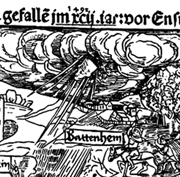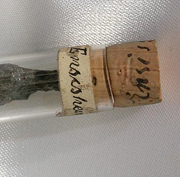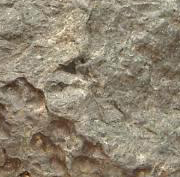Official Name:
Ensisheim has the name of the village where it fell. It is also sometimes called Elsass.
Location:
Just outside the walls of the village of Ensisheim, Alsace, France. At the time, this village in the province of Elsass was part of Germany.
Fall or Find:
Fall
Date:
The fall took place on November 16, 1492, around 11:30 a.m., local time. Ensisheim is the oldest European meteorite from which we have fragments still today.

Enlargement
Woodcut of Ensisheim's fall from the clouds, by Sebastian Brant. It was one of the first artistic works done of the fall. |
|

Enlargement
Fragment (a little over one gram) of the Ensisheim meteorite that has been preserved for over 500 years. |
|
Mass Recovered:
Ensisheim has a mass of approximately 127 kilograms.
Number of Fragments:
When this meteorite hit the ground, it was a single fragment.
Crater:
The meteorite was found in a hole that was 2 metres deep.
Circumstances:
A huge explosion was heard throughout the valley of the Rhine just before the stone fell. Villagers compared the sound to a big clap of thunder followed by an enormous din. Nobody knew what could have caused such an extraordinary noise. Although there were many accounts of the sounds that accompanied the fall, only one person-a young boy-actually saw the meteorite fall from the sky. He led an excited crowd to the wheat field where the newly fallen meteorite lay. Pieces of the stone were immediately broken off for good-luck charms. The mayor of the village quickly put a stop to this activity, because it was altering the "supernatural" stone.
History:
News of the fall spread quickly. Over the centuries, many artists made paintings or wrote poems about the event. The fall even took on political significance. Maximilian I passed through Ensisheim a few weeks after the fall. He decided that the stone was a message from God to go to war against his enemies. Consequently, he ordered the villagers to hang the meteorite in the village church. The stone remained there for over three hundred years. On November 6, 1854, the church's bell tower collapsed, and the stone was moved to the town hall. Today, the meteorite is kept in a museum in Ensisheim called the
Palais de la Régence.
When Ensisheim fell, the extraterrestrial origin of meteorites was not recognized. At the time, it was believed that stones that fell from the sky were formed high in the atmosphere during violent storms. This is why sonic booms were interpreted as claps of thunder.

Enlargement
Main mass of Ensisheim on display at the Palais de la Régence. |
|

Enlargement
The metal is visible in this slice of Ensisheim, but the chondrules are imperceptible due to the metamorphosis inside the parent body. |
|
Type:
Stony meteorite
Class:
Ordinary chondrite
Group:
LL6
Composition:
This chondrite is composed essentially of olivine and pyroxene. Its total iron content accounts for 19.22% of its volume.
Scientific contribution:
Scientists were able to determine the cosmic ray exposure age of the Ensisheim meteoroid. The parent body was bombarded by cosmic rays for 23.3 million years as it wandered through space. That was a long trip!
Comments:
Over the centuries, numerous fragments were broken off the meteorite. Many of these fragments were added to collections throughout the world. Today, the main mass weighs only 56 kilograms and has lost almost all of its original fusion crust.
Part of the Planétarium's collection:
Yes